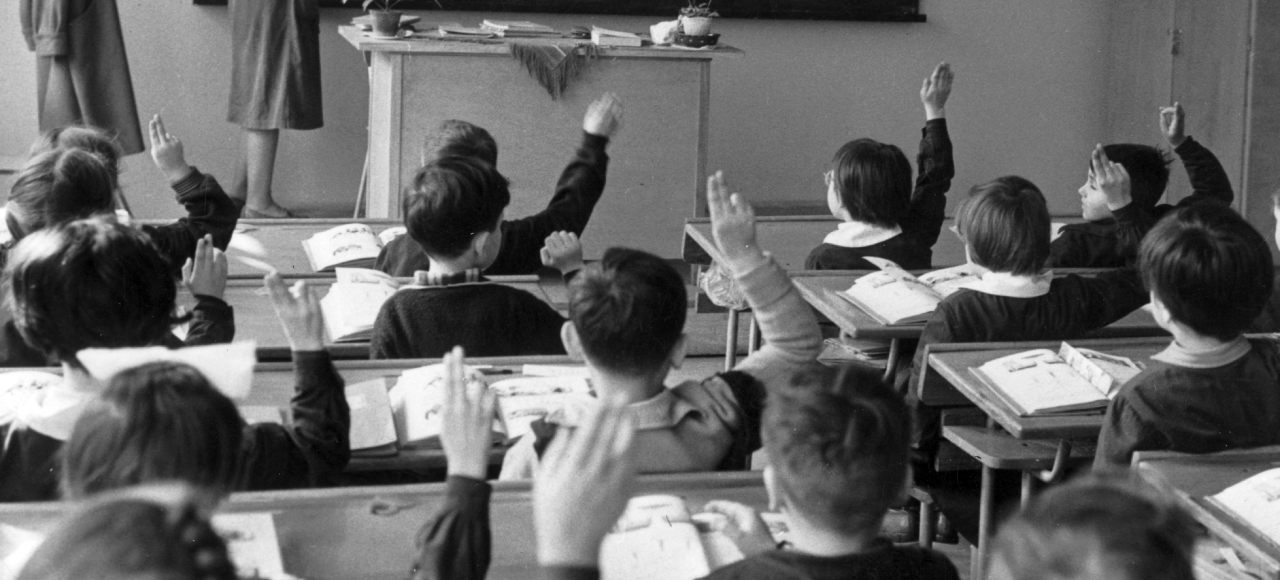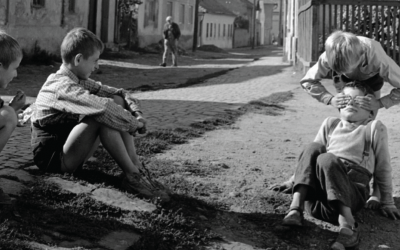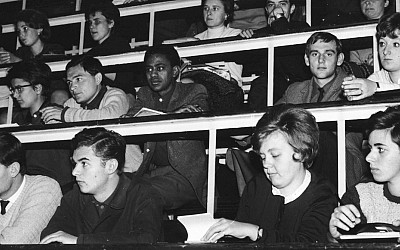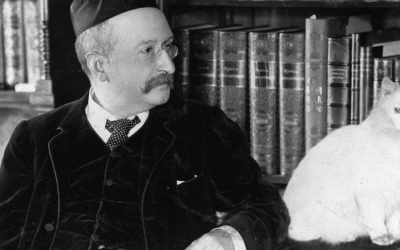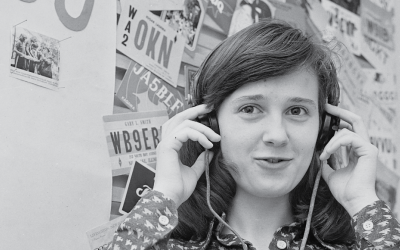Peter Worley argues that philosophy in the classroom depends on a skilled facilitator.
This morning’s philosophy session with a Year 3 (7-year-olds) class in a state primary school in South East London is typical. I walk in and the class quickly re-arranges the classroom to form a horseshoe shape of children. They sit on their chairs looking at me expectantly. I say “Good morning” and then I take out a bunch of board pens held together with an elastic band. Some of the pens are identical, some are different and some are the same make but of different colours. I take out one of the pens, put the others in my back pocket, hold the pen up clearly and go out of the classroom for about five seconds then come back in holding the pen in the other hand. The children couldn’t see me when I was out of the classroom. I ask them the following the question: “Is this the same pen that I went out of the classroom with?” The children start to mutter responses. I say, “Have two minutes to talk to each other about the question,” and the class erupts into discussion.
This is how the class’s weekly, hour-long philosophy session begins this week.
Here is the general procedure that we use at The Philosophy Foundation (TPF):
1) The chairs are arranged to form a horseshoe shape so that the children can see each other, the facilitator and the board, if necessary.
2) Discussion rules are set out that include speaking one at a time (a ball is used to make this easier), listening to the speaker and respecting one another.
3) A stimulus is presented, usually one of the following: a story, a poem, a scenario, a picture book, a puzzle, a short film, some drama, some props with imagined properties such as a stone that always makes you lie. (For example, in the above example I stepped out of the class holding a pen and then stepped back in again.)
4) Either the children simply respond to the stimulus, or a question is asked. If a question is asked I call this a task question. (E.g. “Is this the same pen that I went out of the classroom with?”)
5) If a question is used it is written up on the board for all to see.
6) The children are given a minute or two of talk time to discuss the question or respond to the stimulus in pairs or small groups.
7) The facilitator holds the ball in the air to indicate that a whole class discussion is about to start. The children stop talking to each other and those that have things to say put up their hands.
8) An enquiry ensues for anywhere between two and forty minutes. This is punctuated by more talk times (see step 6), and sometimes some accompanying activities and exercises, extension activities or further parts to a story or scenario. Very often, new questions emerge during the enquiry and sometimes the focus of the enquiry changes. (E.g. “Is knowing it’s the same pen the same as thinking it’s the same pen?” after some children say “I think it’s the same pen” and others say “I know it’s the same pen.”)
9) Sometimes the children are asked to reflect on the discussion, in this case the facilitator asks questions such as: “Did anyone change their mind?” or “Does anyone think they answered/solved today’s question/problem?”
10) For the last few minutes of the hour, and if the children have adhered to the rules well enough, then they are usually rewarded with some kind of game (often related to thinking in some way) at the end of the session.
At TPF we train philosophy graduates to be able to facilitate a philosophical enquiry, what we call “PhiE” (this doesn’t only refer to a “philosophical enquiry,” but also to the particular way in which we do philosophy with groups at TPF). The ten steps described above are a helpful step-by-step procedure and, though this is TPF’s procedure, other procedures for doing philosophy in schools are similar. Most procedures share the “talk circle,” the discussion-based approach, discussion rules, a facilitator, a stimulus and “talk time.”
If someone were to ask how to do philosophy with children, it is tempting to think that one would describe something like the procedure outlined above. However, it is important to point out that one may follow this procedure to the letter and yet it is possible that no philosophy whatsoever occurs. In short: one must not confuse philosophy with a classroom procedure.
So, if this procedure is neither necessary (philosophy is often done without the need for a procedure like this) nor sufficient for philosophy, how do you facilitate a PhiE?
When properly facilitated, the philosophy happens – if it happens – at step 8. Philosophy with children happens best in properly conducted dialogue. My claim is that philosophy is unlikely to happen with young children unless it is facilitated by a skilled facilitator. In this piece I’d like to share some of the techniques and strategies that we’ve developed at TPF for facilitating a PhiE in the classroom by encouraging the right kind of dialogue.
The 4 Rs
First of all, when doing philosophy with children the emphasis is on philosophising – or, the doing of philosophy – rather than the learning about it. I find it helpful to think of philosophising as having four components (not stages). Philosophising is:
· Responsive – Plato said, “Philosophy begins in wonder;” I would add to this that, “Philosophy begins in puzzlement,” when a philosophical problem is recognised and understood as a problem. (For example, “It is fair because we all got the same, but it’s not fair because he was naughty and he still got some!” The problem is: that it is both fair and not fair.)
· Reflective – This usually involves what I call “X questions” but what are more commonly known as ‘Socratic questions’ due to their centrality in Socrates’ method: “What is X?” For example: “So, what is fairness exactly?” This part of the process is exploratory and is often messy, disordered, creative and inconsistent. It’s a kind of “brain-storming” that’s necessary before – or as well as – subjecting the object of enquiry to a rational process of ordering.
· Reasoned – this is a rational, ordered, sequential (that is, step-by-step) and therefore logical attempt to make sense of and ultimately justify a position or positions. The need to find some sort of rational order is often motivated by the tensions, conflicts and apparent contradictions that arise during the responsive and the reflective process. “So, fairness must be… because…” or “Fairness can’t be… because…” or “But if fairness is… then it can’t be…” or “There are different kinds of fairness…” and so on.
· Re-evaluative – Whatever conclusions may have been arrived at during the reasoning part are not simply accepted; they should be subjected to further critical analysis. “Okay, so I think fairness is…, but is that right, because…?”
The key to a good discussion is controversy, and controversy begins with a stimulus and/or a question that is contentious or leads to contention. But that is not always enough; diversity of ideas is needed within the group for the controversy to be understood as such by the group. Here’s how TPF encourage diversity without having to do the all-too-common “devil’s advocate” moves.
The facilitator will most of the time use grammatically closed questions (“So, is it a number?”) but conceptually open questions (the question behind this is “What is a number?”). Grammatically closed questions require students to respond with “yes” / “no” answers or short answers such as “not free.” Appealing to their intuitions, this elicits responses from children without the need to have thought it through first. After all, philosophy often begins with intuitions and then proceeds from tensions that arise from them. By posing questions in a binary form “yes” / “no”) it encourages students to take a position and thereby enter into a dialectical relationship with the question and with each other (“I think ‘yes’ but he thinks ‘no’. Mmm!’”). It may surprise you to find out that by posing questions in binary form it actually encourages the students to challenge the posing of the problem in binary terms. They begin to do so when they say things like, “I think both…’” “I don’t think ‘yes’ or ‘no’…,” “In a way ‘yes’ and in a way ‘no’…” and so on. This kind of language implies that the concepts are more nuanced than the original question seemed to suggest and that, perhaps, distinctions need to be drawn. A good follow-up question when this kind of language occurs is: “So, are there different kinds of X?” (I’ve nicknamed this strategy “Carve it up!”)
Because the facilitator uses a lot of closed questions, he or she will follow up any closed questions with a series of opening-up questions. This affords the focus and specificity of closed questioning but also invites more than one-word answers, ensuring that the discussion doesn’t dry up. Here are the classic opening-up questions (there are plenty more but these are the main ones):
- Justify: “Can you say why you think that?”
- Clarify: “Can you say what you mean by X?”
- Elicit: “Can you say more about that?”
- Exemplify: “Can you give an example of that?”
- Test for implications or entailments: “Can you say what that tells us about…?” or “What do you think that means?”
- Condition: “Can you say what that would depend on?”
- Explain: “Can you say how you would show that…?”
The facilitator will often choose to invite new speakers (at TPF we do this by passing a “talk ball” – a soft ball that indicates who the speaker is at any one time) rather than responding his or herself. Sometimes, by simply allowing new contributions diversity happens naturally, paving the way for philosophy to happen. The key to the success of this simple approach to facilitation is not to respond at all, or, at the very most, with nothing more than a simple “thank you.” Echoing (saying back, to the class, exactly what they said), or eliciting (asking them to say more) are also good, default facilitator responses, if something must be said.
The facilitator will remind the class that they can put their hands up for one of two reasons: 1) to respond to the main question that has been asked or 2) to respond to another speaker. The most common kinds of responses to other speakers are as follows:
- Agreement (“I agree…”)
- Disagreement (“I disagree…”)
- Synthesis (“I agree and disagree…”)
- Add to (“I agree and…”)
- Qualify (“I agree but/if…”)
- Distinguish (“I agree but for a different reason…”)
- Offer an alternative position (“What about…”)
- Counter example (“But what if…”)
If, after trying these two strategies nothing much is happening, then the facilitator may try one or some of the following response detectors – a way of detecting certain kinds of responses within a class of 25 plus:
· “Hands up if you have something to say about the last speaker’s idea.” (The “hands up if…” strategy)
· “Hands up if you want to answer the question and have something different to say to what’s been said before.” Very young classes have a tendency to repeat what others say.
· “Hands up if you have the same answer and have a different reason.” This encourages even very young children to conceptually separate premises from conclusions.
· “Put your thumbs up if you agree; your thumbs down if you disagree and put your thumbs sideways if you think something different to ‘agree’ or ‘disagree’.” (The “thumb poll” strategy)
· If the question is a closed question [e.g. “Is it the same ship?”]:
a) “Hands up if you think ‘Yes, [e.g.] it is the same ship.’” The facilitator takes responses.
b) “Hands up if you think ‘No, [e.g.] it’s not the same ship.’” The facilitator takes responses.
c) “Hands up if you think something different from just ‘yes’ or ‘no’.” The facilitator takes responses.
If someone says something that the facilitator suspects is or will be considered controversial then they might say: “Is there anybody who would like to respond to the last speaker?”
If someone challenges someone else or comments about someone else’s idea, the facilitator may allow the person who has been challenged or commented upon an opportunity to respond (we call it “Right to reply”).
Sometimes the best thing to do is to task the class to come up with as many different answers (or same-answers-different-reasons) as they can rather than simply hoping that they do.
A strategy we call the imaginary disagreer helps to create diversity by encouraging the class to actively seek alternative points of view. This is particularly helpful when unanimity threatens to stifle a good discussion. To implement this the facilitator asks the children to imagine someone who disagrees with them, then asks what they think he or she would say. The next step is to ask them what reason or reasons they think their “imaginary disagree” would give. This can be used with pairs, groups and also with the whole class. Sometimes the children change their own minds because of what their imaginary disagreer said!
From time to time it is important to pass the ball (or to select) those whose hands are not up, or whose hands are never up. Sometimes that really great idea that moves things along comes from someone who would have said nothing had they not been invited to do so.
Sometimes having the students somehow represent what they think of the issue physically or spatially can also be usefully revealing to the facilitator and the class. By doing this the class all get a sense of the “opinion landscape” concerning the question or issue. This can be done in a number of ways. Here’s two suggestions:
- Magnets: place a statement (either the Task Question in statement form or something that’s been said by another student) in the middle of the room written on a piece of A4 paper. Then ask the entire class to stand up and place themselves at a relational distance to the statement according to how far they agree or disagree with it. So, if they strongly agree then they should stand on the statement but if they strongly disagree they should stand by their chair (or by the wall as some of the children I’ve done this with do!). They can also place themselves anyway in between the statement and their chair. (Thanks to Jason Buckley for this idea!)
- True/False: write “True” on one piece of A4 paper and “False” on another. Place these on the floor to form two categories, true and false. Have a statement (either the Task Question in statement form or something that’s been said by another student) written on a piece of paper. Ask students, one at a time, to respond to the statement by placing it in either of the two categories or in between, according to how far they agree or disagree with it. Always gently ask why someone has placed or moved the statement where they have. (Thanks to Steven Campbell Harris for this idea!)
Finally, in situations where what the students think may be affected by what others (peers or teachers) will think of what they say, then anonymity (or putting on Gyges’ ring!) can help to bring out the idea-diversity. The easiest way to do this is to have people write down what they think without writing their name on the paper.
Iffing, anchoring and opening up
“Iffing” (structuring a question in an “If…then…” form). “anchoring” (linking what is said back to the main question) and “opening up” (eliciting reasons for answers given to a grammatically closed question) is a combination of strategies at the heart of the PhiE method that helps to encourage the kind of structured thinking and expression that one finds in argument form (such as modus ponens: “If p then q, p, therefore q”). Using this strategy implicitly invites the students to say whether what they said supports their view on the question. So, if the question is “Can computers think?” then they will either be thinking “yes,” “no,” something else such as “yes and no” or neither, for instance, if they don’t understand the question. If they hold a positive, unqualified thesis (either “yes” or “no”) then the question is turned into a statement. For example, “Yes, I think computers can think.” This is their conclusion. But children don’t always say all of this, they might just say, “Thinking is just calculating.” The facilitator ifs this and then anchors it to the main question: “If thinking is just calculating, then can computers think?” the student is brought to decide (or recognise) what conclusion this brings them to have, albeit provisionally (they may change their minds later). For example, they may say, “Yes.” Then a simple opening up question lets us in to their reasons (or premises): “Would you like to say why?,” “Because computers calculate so…” The implicit argument here uses the modens ponens move:
1) If computers calculate then they can think (because calculating is thinking)
2) Computers calculate.
3) Therefore computers can think.
From a logical point of view, this also affords the facilitator a legitimate opportunity to introduce a possible controversy to the class/group: “Is calculating the same as thinking?” because, that “calculating is just thinking” is an assumption that, according to the logical and sequential demands of a philosophical conversation, needs to be questioned.
In conclusion, these are some of the main techniques and strategies we’ve developed at TPF that help a facilitator bring about a genuine philosophical enquiry (one that is responsive, reflective, reasoned and re-evaluative) with groups of people including groups of very young children. What I will say about the procedure outlined at the start of this piece (and others like it) is that, though it is neither necessary nor sufficient for doing philosophy, when coupled with good facilitation such as that described in this piece, it is conducive to bringing a group of people, especially children, to do philosophy. In this way, it is the best procedure for doing philosophy with children that I know of, as long as one does not think that it is the philosophy. As Plato said, philosophy begins in wonder. But it doesn’t follow from that, that just because you are wondering, you are philosophising. Something more is needed for that to happen.
{fastsocialshare}
PETER IS FOUNDER AND CEO OF THE PHILOSOPHY FOUNDATION AND A VISITING RESEARCH ASSOCIATE AT KINGS COLLEGE LONDON. THIS ARTICLE IS ADAPTED FROM HIS FORTHCOMING BOOK, 40 LESSONS TO GET CHILDREN THINKING (BLOOMSBURY).

